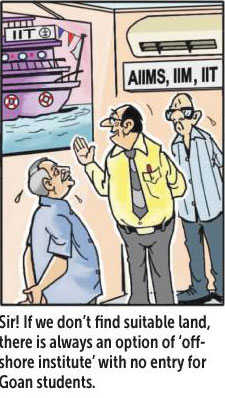29 Dec 2019 | 04:56am IST
Wonderful Goa losing its lustre
RAHUL SINGH
I first went to Goa in 1967 to report for a national daily on the “Opinion Poll”, a referendum of Goans, on whether they wanted to merge with neighbouring Maharashtra, or remain more autonomous. Earlier, in December 1961, the Indian army had marched into the territory “liberating” it after 450 years of Portuguese rule. The operation lasted just 36 hours and was virtually bloodless. To everybody’s surprise, in the “Opinion Poll” Goans decided to become a Union Territory, more in control of their own affairs (a few years later Goa was given statehood).
On that first visit I fell headlong in love with the place and its people. Enchanting scenery, beautiful beaches with clear waters, and warm, friendly inhabitants. I was so entirely captivated that some years later I bought a tiny studio apartment, walking distance from the beach, for less than four lakhs. I found the mix of Christianity and Hinduism, with a little bit of Islam, all the communities living in harmony, unique. Magnificent churches and quaint chapels dotted the countryside, mainly near the coast, while the Hindu temples were more in the interior. Prime among them were the Shantadurga and Mangeshi (where Lata Mangeshkar comes from) temples, which attracts thousands of devotees every day. Most people think Goa is largely Christian and Roman Catholic. Actually, 60 percent of Goans are Hindus. However, the main tourist attractions are along the coast where most of the Catholics reside. This was where the Portuguese first came, hence they are called the “old conquests”, as opposed to the “new conquests”, where the Hindus are concentrated.
Since that first trip in 1967, I have been to Goa many times. My favourite time of the year is the festive season, Christmas and New Year. The climate is just right, neither too hot, nor too cold. Many of the houses and bars are festooned with coloured lights, Santa Clauses adorn street corners, and nativity scenes (birth of Jesus Christ) are beautifully displayed in gardens. The churches reverberate with Christmas carols and there is an air of rejoicing in which everybody, of all religious persuasions, participates. The bars and hotels serve all kinds of foods, and a variety of alcoholic beverages. My favourite is cashew “feni”, a fermented spirit made from the juice of the cashew apple that is peculiar to Goa.
This is what all of India should be like – inclusive and tolerant. Which I believe is why so many “outsiders” have bought or rented a second home in Goa (housing is still relatively affordable). For Delhiwallahs, Goa is often also an escape from pollution. The food and drink are incredibly cheap and varied. The first meal for many Indian non-veg tourists is a beef concoction, such as a beef steak or beef chilly fry, having been deprived of it in most parts of the country. Mind you, a Hindu-nationalist BJP government is in power presently in Goa but it knows that Goans, Hindus and Christians, as well as the foreign tourists, don’t want to be told what they can eat and drink. Little wonder that foreigners have been coming to Goa in droves, mainly on cheap chartered flights.
I wish I could end on a positive note. Goa’s infrastructure has certainly improved over the years – there used to be infuriating and regular power cuts and intermittent water supply – and there is also more on offer culture-wise – an international film festival is held every year and a “Serendipity” arts fair takes place in Panjim, the capital city. This year, however, there are far fewer tourists than in earlier years. The numerous chartered flights have dried up, some say because of the closing down of Thomas Cook. Unplanned, ugly construction is rapidly ruining the earlier charming landscape. I notice that the once warm and friendly Goans are beginning to resent the presence of so many “outsiders”, some of whom are not sensitive to Goan sensibilities.
Compliments of the season and a Happy New Year!
